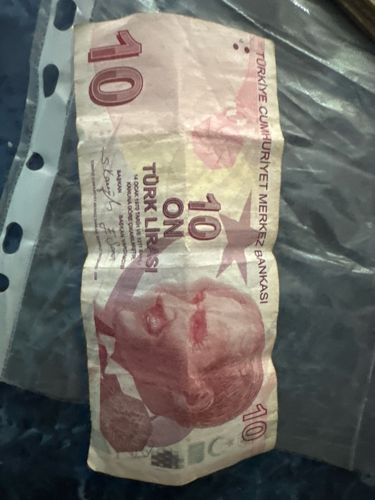Turkish Lira Banknote (Banknot)
Country of Origin: Turkey
Year of Issue: This is a banknote, not a coin. The year of issue will be printed on the banknote, usually as a series date or actual issue date. Based on the design, specifically the portrait of Atatürk and the "ON TÜRK LİRASI" text, this appears to be a 10 Turkish Lira banknote from the E9 Emission Group, which started circulating in 2009. The text "14 OCAK 1970 TARIH VE 1211 SAYILI KANUNA GORE CIKARILMISTIR" on the banknote refers to the legal basis for issuing banknotes in Turkey, not the actual issue date of this specific series.
Denomination: 10 Turkish Lira (On Türk Lirası)
Composition: Paper (specifically, banknote paper, which is a blend of cotton and linen fibers)

Brief Description
The banknote features a prominent portrait of Mustafa Kemal Atatürk, the founder of the Republic of Turkey, on the front. "10" and "ON TÜRK LİRASI" are clearly visible. The text "TÜRKİYE CUMHURİYET MERKEZ BANKASI" (Central Bank of the Republic of Turkey) is also present. The color appears to be a reddish-brown or light brown hue.
Historical Significance
This banknote is part of modern Turkish currency. Mustafa Kemal Atatürk is a central figure in Turkish history, revered as the founder of the modern Republic of Turkey. His image is ubiquitous on Turkish currency, symbolizing the country's secular and national identity. The Turkish Lira itself has undergone several revaluations and changes, reflecting Turkey's economic history.
Estimated Value
As a circulating banknote, its face value is 10 Turkish Lira. Its collector's value depends heavily on its condition (PMG or PCGS grading), series, and any specific variants/errors. A heavily circulated note like the one pictured would likely have little to no value above its face value, unless it possesses a rare serial number or print error. As of late 2023/early 2024, 10 Turkish Lira is roughly equivalent to 0.30 - 0.35 USD, depending on exchange rates. This value is subject to fluctuations.
Care Instructions
To preserve banknotes, it is recommended to handle them by the edges to avoid transferring oils from hands, store them flat in acid-free sleeves or albums, and keep them away from direct sunlight, moisture, and extreme temperatures. Avoid folding, creasing, or writing on the note. For a note in this condition, primary care would be to prevent further deterioration, although significant restoration is not typically practical or recommended for common circulated notes.
Created At: 2025-09-06T12:21:36.197074